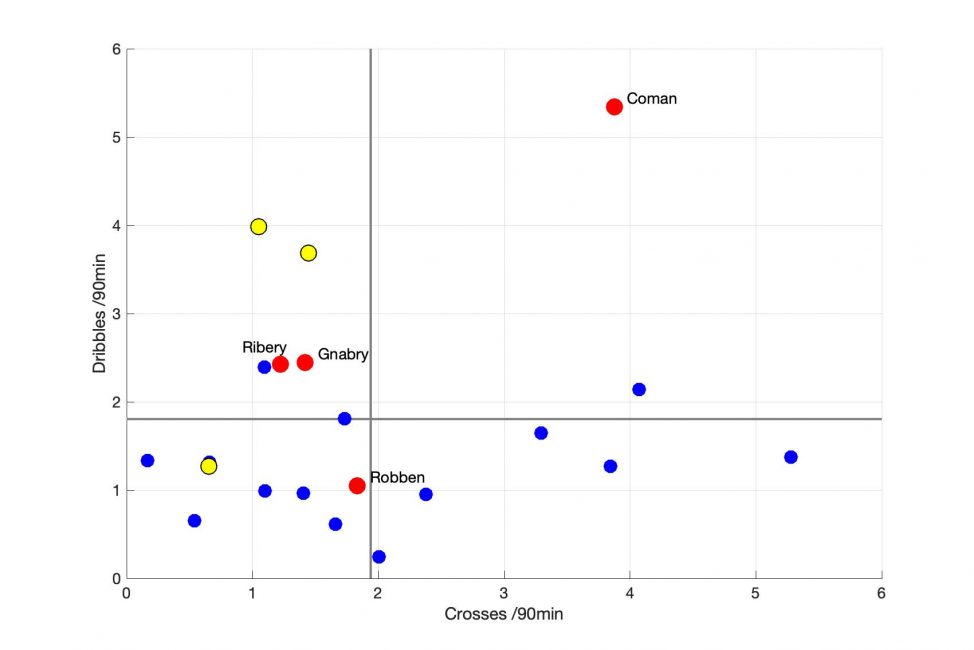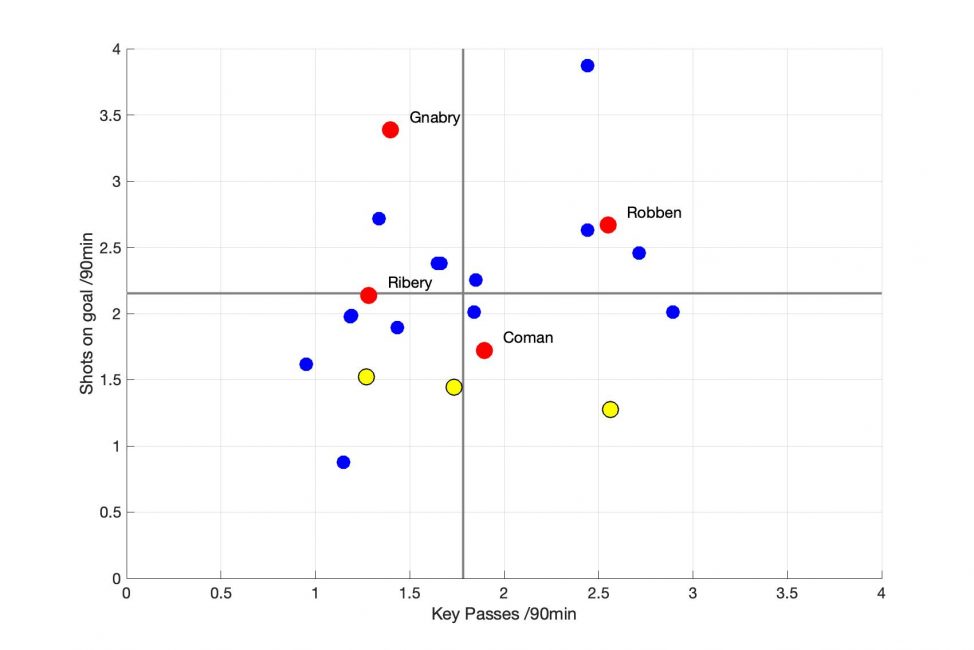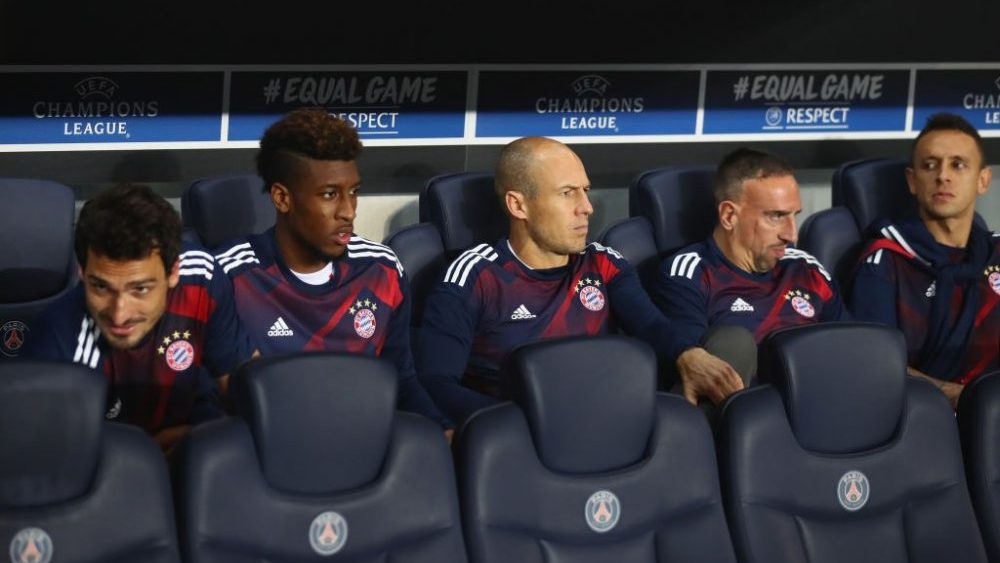Stats&Links: Opposite wings
Despite all speculation and public advertising, Hudson-Odoi did not move to Munich at the end of the day. Therefore, the old acquaintances will have to do it: The duo Robbery, who are on their farewell tour, the lively Frenchman Coman, who returned from a long injury misery before the winter break, and Gnabry, who has a strong finish and brought the Munich team to victory against VfB Stuttgart last week. The young Canadian Davies, who was hired by the Vancouver Whitecaps, also joins in.
But what can you expect from the individual players? What role can they play in the system of coach Kovač? We took a look at the statistics and compared the Bayern wingers with their national competition this season.
The skillset of a winger
Since the arrival of Arjen Robben in the summer of 2009, the Bavarian system – sometimes more, sometimes less – has been geared towards the wing players beating their direct opponent by winning one-on-one situations and thus penetrating the penalty area. In combination with a fullback, this overload of an attacking side can become a dangerous scoring chance.
In the best case scenario, such an attack ends with the winger’s, who has won the dribble, shot at goal or with a considered pass either towards the striker close to the five-meter space or into the back of the defense to an approaching midfielder. In the past, Robben often preferred to finish with his strong left foot, while his counterpart Ribéry often sought the pass to the centre. For a cross, the ball was usually passed to the fullback.

(Image: Maurice)
In order to analyse how good at dribbling Bayern’s wingers are, the dribbles per 90 minutes were considered and compared to the beaten crosses per 90 minutes. The numbers are calculated at 90 minutes to ensure better comparability. The Munich players are shown in red in the graph. Players of current leader Dortmund – Sancho, Larsen, Pulisic – were marked in black and yellow. Marco Reus was not included because he played most of his games in central midfield. The remaining players, fourteen wing strikers from various Bundesliga clubs, are shown in blue. A horizontal and a vertical line, which represent the respective mean value, are drawn as a further aid.
Crossing and dribbling with King(sley)
Looking at the diagram, Kingsley Coman seems to be quite alone. With currently 5.34 won dribbles per 90 minutes he clearly leads the field. The Frenchman manages to sprint past his direct opponents again and again with his explosive start. If an opponent does not double him, the defender is usually fighting a losing battle. However, it must be noted that Coman has only played a total of 418 minutes this season, which leads to outliers being more weighted.
Nevertheless, the other Bayern players follow in some distance. Ribéry and Gnabry are close to each other with 2.45 and 2.42 dribbles, respectively, and are still well above the average, while Robben falls off with just 1.05 take-ons. This confirms the famous eye-test, which this year leaves one with the feeling that the Dutchman has lost some of his explosiveness. From Dortmund, Pulisic (3.69) and Sancho (3.99) are the strongest dribblers.
However, it is also noticeable that Coman is well ahead in the crosses that were beaten – at 3.88 crosses per 90 minutes for the 22-year-old. Only Kostic (3.84), Bailey (4.07) and Bellarabi (5.28) can keep up in the Bundesliga. This once again shows an old problem of Coman. After a won dribbling he often still lacks the necessary sovereignty, which still distinguishes him from the likes of Ribéry. Instead of passing the ball in the middle with patience and clarity, or looking for his own shot, the native Parisian often opts for the fast, ill-advised flank. Under Heynckes he had shown a strong improvement in this area and it is to be hoped that he will find his way back to this level after his injury.
The rest of the Bayern side are much less likely to hit a cross. Robben is ahead of Gnabry (1.42) and Ribéry (1.22) this season with 1.82 crosses per 90 minutes.
Robben dishes dangerously
But what about situations where a dribble is won and the attack doesn’t end in a cross? Which Munich winger is the most eager to finish and who plays the most dangerous passes?
We have taken a look at the number of shots on goal per 90 minutes. We compared this with the number of key passes, i.e. the number of passes that led to a goalscoring chance. Again, the Bayern players are highlighted in red and the Dortmund players in black and yellow. The selection of the other players is also identical to the first representation.

(Image: Maurice)
The upper right quadrant shows the players who take more shots and play more key passes than the league average. These criteria are met by five players: Hazard, Bailey, Bellarabi, Mehmedi and also Robben. The Dutchman clearly leads the team with 2.55 key passes per 90 minutes. In the league he is only behind Brandt, Hazard and Sancho. Although Robben is above the league average with 2.67 shots on goal per 90 minutes, this figure is one of the lowest in his career. According to the similar metric of shots on goal per game, he takes 1.9 shots on average in the Bundesliga this season, the lowest ever.
Gnabry loves to shoot
However, Gnabry is taking over this part. The young German national player achieves an average of 3.39 points per 90 minutes. By way of comparison, Robert Lewandowski, the striker at the record champion’s side, only achieves a slightly higher number of 3.93 shots on goal in the same period. It is also notable that only 37% of his shots go on goal. This puts him on par with Ribéry (40%). Both Robben (56%) and Coman (60%) are clearly above this value. An indication that Gnabry also likes to shoot in difficult situations.
This assumption is confirmed by looking at expected goals (xG). These show how likely a goal is to be scored. It therefore includes the distance to the goal as well as the number of opponents up to the goal in its calculation. We will use this metric to look at how many completions a player needs on average for an xG. A low value speaks for high quality shots. In this parameter, Gnabry is also on the last rank of the considered Bayern players with 9.75 shots per xG. Robben has the best score with 7.08 shots per xG, while Coman (7.48) and Ribéry (9.01) follow. For comparison: Sancho has an incredible 4.61 shots per xG.
With only 1.4 key passes, Arsenal’s former talent is in the lower third of the league. These numbers can be interpreted that Gnabry should pass to a better positioned player more often. However, his somewhat unconventional finishes and his goal instinct were often kind of a can opener during the season. At his former club Bremen he shot the important 1:0 and scored the final score with 2:1. Last weekend against Stuttgart, his shot led to an own goal by Gentner, which brought the Bayern team back into the lead.
Ribéry and Coman are both roughly among the league’s average in the graphic, with Coman tending to finish less often and playing the dangerous pass more often. For his French partner, the situation is the other way round. The young Frenchman also leads all Bayern players in the metric “expected Assists per 90 minutes”.
The more, the better
With all the love for statistics and new metrics, in the end the result on the scoreboard is still the most important number in football. Therefore, a look at the goal and assists of the individual players will be taken. These scorer points are displayed above the potential scorer points, i.e. the sum of all shots and key passes. All values are again referenced to 90 minutes.

(Image: Maurice)
The Munich winger with the most goal participations is Gnabry. The young international already has 7 scorer points on his account this season. This corresponds to 0.76 per 90 minutes. Only Sancho, Hazard and Herrmann are ahead of him in the Bundesliga. With 15 scorer points, the Belgian and the Englishman also lead all players in absolute numbers. Gnabry creates 4.78 dangerous actions per 90 minutes.
In this metric Robben is second in the league behind Bellarabi with 5.22 actions per 90 minutes. However, the Dutchman has lost some of his former scoring ability. This season he scored three goals in nine games. Two years ago, the Wembley scorer had more than twice as many scorer points per 90 minutes. However, Robben is still slightly above the league average. Ribéry, on the other hand, is slightly below average.
Coman is a bit lower in this metric, as he has not yet scored a goal in his eight appearances nor assisted one. However, this statistic is not to be overestimated due to his short playing time, since in football in general few goals are scored. Nevertheless, Gladbach’s Herrmann has five scorer points in the same playing time.
Preview on the second half
After this detailed look into the statistics, we will look into the future. What can we expect from the Bavarian wingers? And where is potential room for improvement?
It’s interesting that the young duo of Gnabry and Coman seem to complement each other perfectly. While the Frenchman is very strong in dribbles, likes to look for crosses and also plays dangerous passes, the German has his flashes with his dangerous finishes and his fast sprints – Gnabry is on 3rd place in the league with the number of sprints per 90 minutes. Now one could wish that Coman uses his won dribbles even more often to look for the finish himself and that Gnabry puts the ball to the better positioned teammate more often. But just perhaps, it’s exactly these contrasts that make this winger duo special and dangerous.
At least Coman’s improvement this season should be helped by the fact that when Gnabry is playing, he is lined up on the left side. With his stronger right foot, he can act as an inverted winger and seek the path to the middle more often. This could lead to more finishes. On the right side, he often only had the path over the outside. There a cross was usually without an alternative, if he didn’t want to take the tempo out of the attack again.
With Ribéry and Robben it is clearly visible that both have regressed over the last two years. The statistics confirm this. Robben seems to have to adapt his role even more than Ribéry. The Dutchman has to accept that his speed is no longer enough to beat his opponent at the highest level. The interaction with Kimmich on the wing will become even more important. He can always be trusted to score in big moments, but it wouldn’t surprise, if the 35-year-old focussed his role even more on interacting with teammates and creating goal chances.
For his former congenial partner the change is less dramatic, as Ribéry has always had an excellent relationship with Alaba and has always preferred to beat defensive lines together with the Austrian rather than alone. In most metrics, the Frenchman is in the midfield of the league. But at the end of the first half of the season, he showed once again that he too can continue to provide great moments in important games.
A division of roles in which Coman and Gnabry play from the beginning and are then replaced by Robben and/or Ribéry towards the end of the game seems conceivable in any case. The opposite is also possible, as Kovač hopes to outwit the already worn out and tired opponent with the speed of Coman and Gnabry. The quartet is complemented by the young Alphonso Davies, whose role, however, will hardly grow beyond that of the substitute in the final minutes of an already decided game.
It would fit into the previous actions of Kovač, if the Croatian relied on the older version with Robbery in the important games. It is to be hoped, however, that he will jump over his shadow and let Gnabry and Coman grow into the roles they will have to fill next season anyway.
Links of the week
Tactical Analysis: Bayern Munich vs Stuttgart | Tobias Hahn | Total Football Analysis
Manuel Neuer’s struggles are hurting Bayern Munich | Mike Goodman | StatsBomb
Pressure mounts on Bayern’s future at midfield after Callum Hudson-Odoi miss | Raphael Honigstein | ESPN
Current Miasanrot-Articles
Three Points, job done: A trio of takeaways from FC Bayern v VfB Stuttgart | Rick
Club Crawl: FC Bayern Supporters San Diego | Marc
Exclusive interview with David Krecidlo (U19) | Martin | Sam
Current Statistics and Visualizations
You are currently viewing a placeholder content from X. To access the actual content, click the button below. Please note that doing so will share data with third-party providers.









